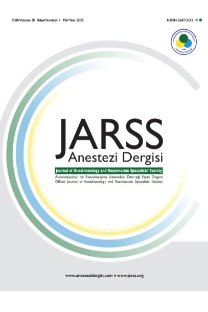Comparison of Pressure Volume Loop Closure with Just to Seal Technique to Guide Endotracheal Tube Cuff Inflation and to Assess the Incidence of Sore Throat, Cough and Hoarseness of Voice - A Prospective Randomized Controlled Trial
Endotrakeal Tüp Kafının Şişirilmesine Yön Vermek İçin Basınç Hacim Halkası Kapanması ile Hava Geçirmeyecek Kadar Tekniğinin Karşılaştırılması ve Boğaz Ağrısı, Öksürük ve Ses Kısıklığı İnsidansının Değerlendirmesi-Prospektif Randomize Kontrollü Bir Çalışma
___
Hamilton VA, Grap MJ. The role of the endotracheal tube cuff in microaspiration. Heart Lung J Crit Care. 2012;41:167-72. https://doi.org/10.1016/j.hrtlng.2011.09.001Feng TR. Critical importance of tracheal tube cuff pres- sure management. World J Anesthesiol. 2015;4:10. https://doi.org/10.5313/wja.v4.i2.10
Reed MF, Mathisen DJ. Tracheoesophageal fistula. Chest Surg Clin N Am. 2003;13:271-89. https://doi.org/10.1016/S1052-3359(03)00030-9
Striebel HW, Pinkwart LU, Karavias T. Tracheal rupture caused by overinflation of endotracheal tube cuff. Anaesthesist. 1995;44:186-8. https://doi.org/10.1007/s001010050146
El-Orbany M, Salem MR. Endotracheal Tube Cuff Leaks: Causes, Consequences, and Management. Anesth Analg. 2013;117:428-34. https://doi.org/10.1213/ANE.0b013e318292ee21
Tsaousi G, Oloktsidou I, Tsiaousi A, Gkinas D, Vasilakos D. Assessment of four methods of endotracheal tube cuff inflation in terms of optimal cuff sealing. Eur J Anaesthesiol [19AP4-5]. 2014;31:278-9. https://doi.org/10.1097/00003643-201406001-00805
Jain M, Tripathi C. Endotracheal tube cuff pressure monitoring during neurosurgery - Manual vs. automa- tic method. J Anaesthesiol Clin Pharmacol. 2011;27:358. https://doi.org/10.4103/0970-9185.83682
Kaki A, Almarakbi W. Tracheal tube cuff inflation gui- ded by pressure volume loop closure associated with lower postoperative cuff-related complications: Prospective, randomized clinical trial. Saudi J Anaesth. 2014;8:328. https://doi.org/10.4103/1658-354X.136422
Kaki AM, Almarakbi WA. Use of pressure volume loop closure to check for endotracheal tube cuff function. Saudi J Anaesth. 2012;33:1185-9.
Rajan S, Tosh P, Paul J, Kumar L. Effect of inhaled bude- sonide suspension, administered using a metered dose inhaler, on post-operative sore throat, hoarseness of voice and cough. Indian J Anaesth. 2018;62:66. https://doi.org/10.4103/ija.IJA_382_17
Liu J, Zhang X, Gong W, et al. Correlations between controlled endotracheal tube cuff pressure and post procedural complications: a multicenter study. Anesth Analg. 2010;111:1133-7. https://doi.org/10.1213/ANE.0b013e3181f2ecc7
Hu BJ, Xu J, Zhao XH, et al. Impact of endotracheal tube cuff pressure on postoperative sore throat: A systema- tic review and meta-analysis. J Anesth Perioper Med. 2016;3:171-6. https://doi.org/10.24015/JAPM.2016.0022
Morris LG, Zoumalan RA, Roccaforte JD, Amin MR. Monitoring tracheal tube cuff pressures in the intensive care unit: a comparison of digital palpation and mano- metry. Ann Otol Rhinol Laryngol. 2007;116:639-42. https://doi.org/10.1177/000348940711600902
Sengupta P, Sessler DI, Maglinger P, et al. Endotracheal tube cuff pressure in three hospitals and the volume required to produce an appropriate cuff pressure. BMC Anesthesiol. 2004;4:8. https://doi.org/10.1186/1471-2253-4-8
- ISSN: 1300-0578
- Yayın Aralığı: 4
- Başlangıç: 1993
- Yayıncı: Betül Kartal
Elif ERDOĞAN, Merve ZIVALI, Ali Bestemi KEPEKÇİ
Etkili Kalıplarla İngilizce Makale Nasıl Yazılır?
How to Write an Article in English with Effective Phrases?
GAMZE KÜÇÜKOSMAN, Hüseyin ÖZTOPRAK, Tuğçe ÖZTÜRK, HİLAL AYOĞLU
Venkatesh SELVARAJ, Rajkumaran KAMARAJ
İlkay BARAN, Savaş ALTINSOY, Özge YAMANKILIÇ MUMCU, Aslı DÖNMEZ
Gamze KÜÇÜKOSMAN, Tuğçe ÖZTÜRK, Hüseyin ÖZTOPRAK, Hilal AYOĞLU
Venkatesh SELVARAJ, Rajkumaran KAMARAJ
MAHMUT ALP KARAHAN, NURAY ALTAY, EVREN BÜYÜKFIRAT, ORHAN BİNİCİ, MEHMET KENAN EROL, BAŞAK PEHLİVAN, VELİ FAHRİ PEHLİVAN, ERDOĞAN DURAN, AHMET ATLAS
